Content
Almost all flowers that can be found in hypermarkets or specialty stores can be classified according to several criteria.
Firstly, is it possible to keep the plant outdoors, or is it an exclusively home option. Secondly, the temperature conditions of the soil, how often they need to be watered, and whether they like light. Depending on which class the plant belongs to, any amateur and professional will be able to find the necessary care.
Host classification
There are several classification options that are used around the world. First of all, all types are distributed according to the principle of the shape of the bush (in this case, these are five groups) or from the height. It is worth noting that most of the forms and colors of such an interesting bush are the efforts of breeders from all over the world, so every year they continue to delight many gardeners with interesting hosta broods. According to the American classification, there are only six groups of hosts:
- Dwarfs. In the event that the height of the brood is not more than ten cm.
- Miniatures. If the brood height fluctuates between ten and fifteen cm.
- Small hosts... As a rule, their height does not exceed twenty-five cm.
- Average host. The most popular and demanded group, as it includes specimens not exceeding 50 cm in height.
- Big hosts. Height from 55 to 70 cm.
- Giant host. The height of the bush is over 70 cm.
Despite such a clear and understandable classification, there are intermediate options, depending on their height.
Hosta varieties
Since it is already known that the hosta has become a large group, which includes both natural representatives and artificially bred specimens, many gardeners are used to dividing them into the following varieties:
- Bloated. The cultivars are popular for their heart-shaped leaves with pointed tips. Some representatives of this group can reach one meter and, during flowering, delight their owner with beautiful purple flowers.
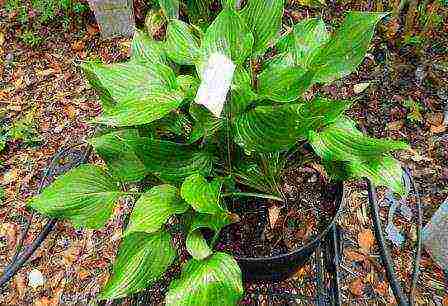
- Wavy. They can be completely different in color. All varieties are united by an interesting shape of the leaves. Long and oblong, they seem to curl a little in small waves. As a rule, the largest representatives can grow up to 80cm.
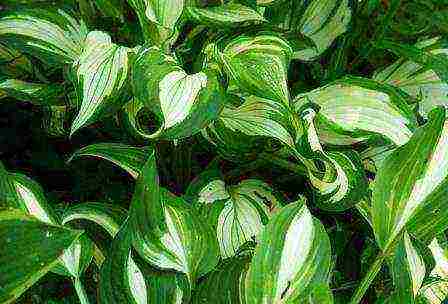
- White-bordered. It is not difficult to guess that the varieties of such hosts are united by a white border, which visually, like a shell, covers the green juicy leaf. Most often, their length does not exceed 30 cm.

- Decorative. They differ in that during ripening they release beautiful flowers of a gentle lilac color. The leaves are most commonly seen as dark green with a bright white border.
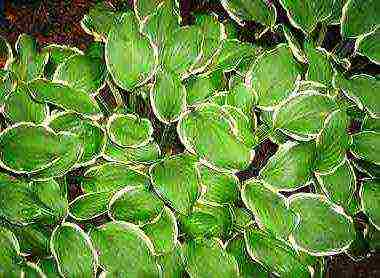
- Siebold. Unique blue color of dense and wrinkled leaves. Most often produces white flowers. Since the leaves are large and longitudinal, their height can reach up to 40 cm.
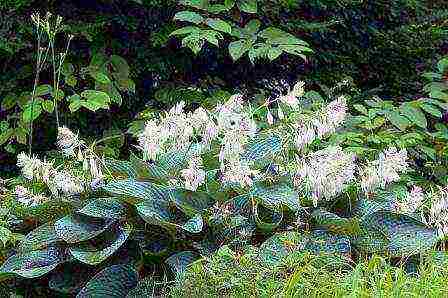
The best hosta varieties
Over the past few years, the demand for hosts has increased markedly, which is why it is considered one of the most popular garden plant species. Since each variety is unique in its own way, there are a number of almost invisible differences, so sometimes it is very easy to make a mistake. In most cases, you can choose almost any variety that meets the required criteria.
But experienced gardeners know that if they need a resistant plant that will please not a single year if properly cared for, then these are medium-sized varieties. If you choose miniatures, then they are much more capricious and sensitive to cold temperatures, therefore, throughout the entire time it is necessary to maintain the most comfortable conditions.
- Thunderbolt grade... Most often it grows quite large, but you should pay attention to its interesting powerful and dense leaves. In the summer, its longitudinal spots in the core of the leaf are most often yellow, and with the onset of frost or cold season, they turn white. The optimal conditions for the content will be necessarily shade, it is better to avoid direct sunlight. Handles winter well in a regular seedling container.
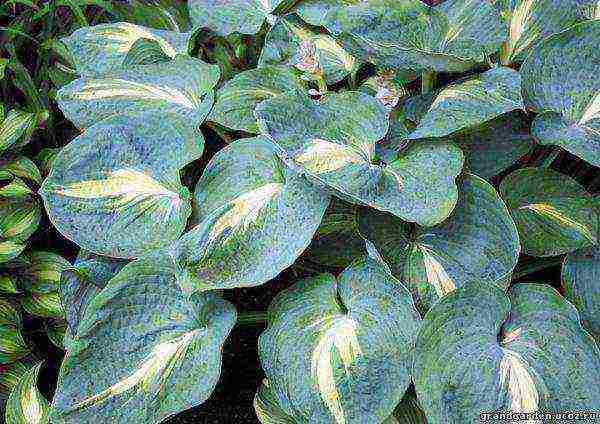
- Sort "First Frost"... This is a very popular variety, which was recognized as the discovery of the year just 6 years ago. Most often it is classified in the middle category, since it does not grow more than 30-35 cm in height.However, we can say that due to its fluffiness, it is worth leaving at least a meter of space for it. Depending on the temperature regime, the variety changes the color of the leaves from blue to green.

- Sort "Sum and Substance"... Each owner of his own plot or garden is simply obliged to plant such a gorgeous and truly gigantic host. Most often, its height is at least 80 cm. The color can vary from normal to dark green. The leaves are wavy and wide, creating a true tropical tree effect. It is also worth noting that, regardless of the season, the plant is never attacked by harmful insects or slugs. In spring, it is recommended to use complex fertilizers for some time to maintain the "green hair". Always loves abundant watering. It is better to keep it in a medium shaded area, where several rays of the sun can reach.
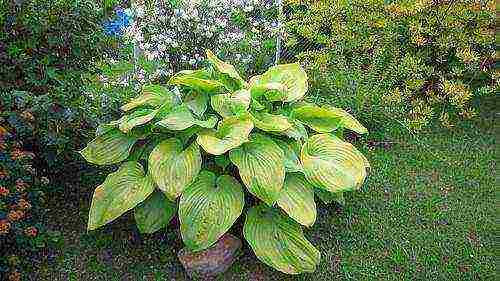
- Captain's Adventure variety. Some gardeners are used to calling this variety waffle, due to the unusual and interesting structure of the leaves. As a rule, the shape of the leaves itself is oval, but not wide. The play of colors on the surface of the leaf is also of great interest, since the border is always clearly separated from the light core by a dark green interlayer. Loves both shadow and evenly diffused light. The plant looks very beautiful during its flowering with delicate lilac flowers.
- Lakeside Dragonfly". A very convenient variety that is perfect for a modest garden or plot. The maximum height that a plant can reach does not exceed 30 cm. The leaves themselves are light green, long and narrow. From mid-summer to the beginning of the autumn season, it pleases every owner with a purple bloom. Not a picky plant that can be perfectly kept in a spacious pot or seedling tub. Since this species grows very slowly, it must take at least five years to separate it.

- Variety "T-Rex"... Absolutely not everyone can afford such a variety of hosts, since sometimes it can reach a height of more than one and a half meters. Beautiful, bright green color, the plant has a wavy structure and at times resembles a giant rose. If you plant it in your garden, then, of course, the whole emphasis will converge on it. It gets along well with other hosta varieties, not picky. Shade tolerates well. It can bloom with small white flowers throughout the season.
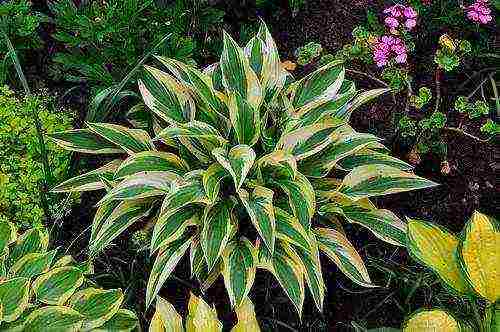
- Variety "So Sweet"... Perfect for those gardeners who do not have a lot of space. Best kept in the garden, as it smells very strong during flowering. It has a sharp leaf shape, which visually seem to be peaks, due to the white frame. Since it tolerates open sunny areas or shady areas equally well, you can use it wherever it is convenient. Alternatively, it can be used to decorate the border in combination with roses.
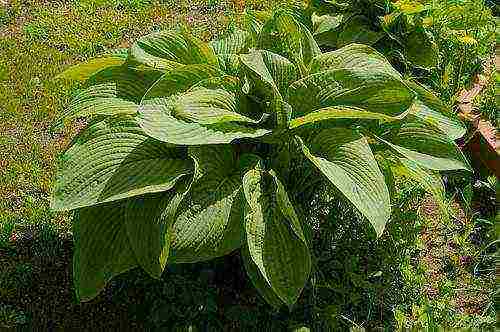
- Variety "Blue Ivory"... Due to its unusual shape and color, this hosta variety is very popular and relatively recently entered the landscape design trend. An unusual change in color: in the summer, the leaves are blue with a lilac border, and after the end of the season, a green tint prevails in combination with a white border. It belongs to the middle group of shrubs, since its height does not exceed half a meter. This hosta loves a lot of shade. It is combined with many plants, so there are practically no problems in grooming.
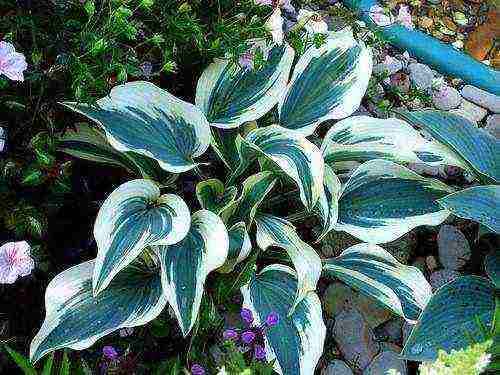
- Variety "Liberty"... Belong to a tall group of bushes. The bright and positive color of the leaves will fit into any garden. It grows no more than 80 cm high. Since by the beginning of the season, its border is yellow, sunny in color, by the beginning of autumn, it is often dominated by an almost whitish shade. It is recommended to keep it in a sunny place, as due to a shortage, the bush can turn completely green, losing its unique color.

Small notes on growing
Before deciding which variety a person will grow, it is very important to find out information about its photophilousness. The fact is that some hosts prefer diffused uniform light, some prefer darkened places, and other hosts do not mind taking all the sun for themselves. If such information could not be obtained, then you can orient by the color of the plant.
In varieties that have light cores or veins, they definitely love light rooms. The lighter they are, the more sun should be. Since these varieties practically do not have chlorophyll, they remain light at most until the end of the years, then their leaves turn dark green, due to the supply of starch in the roots.
It is also important to know that some varieties are a favorite treat for insects and slugs, so it is very important to spray them with prophylactic agents from time to time.
Watering should be "good", since almost any type of hosta requires a lot of water, regardless of its location. Most gardeners start to get upset, because after planting the bush visually differs from what could be depicted in the picture. However, do not despair, since most of the host's functions are revealed over time and can take up to five years. Therefore, its visual appearance may change a few more times.
Video consultation on care
Tells Maxim Telyupa in the video blog "Good advice".
Home page ›Forums› Flower garden and landscape ›Ornamental plants and their care› Interesting and unusual host varieties
This thread has 30 replies, 1 participant, last updated Maxim Savinov 1 week, 4 days back.
Viewing 10 posts - 1 through 10 (of 31 total)
1 2 … 4 →
-
author
Posts
- February 27, 2016 at 05:29 PM # 58567
Savinov Maxim
Moderator
Hosta ‘Fire and Ice’
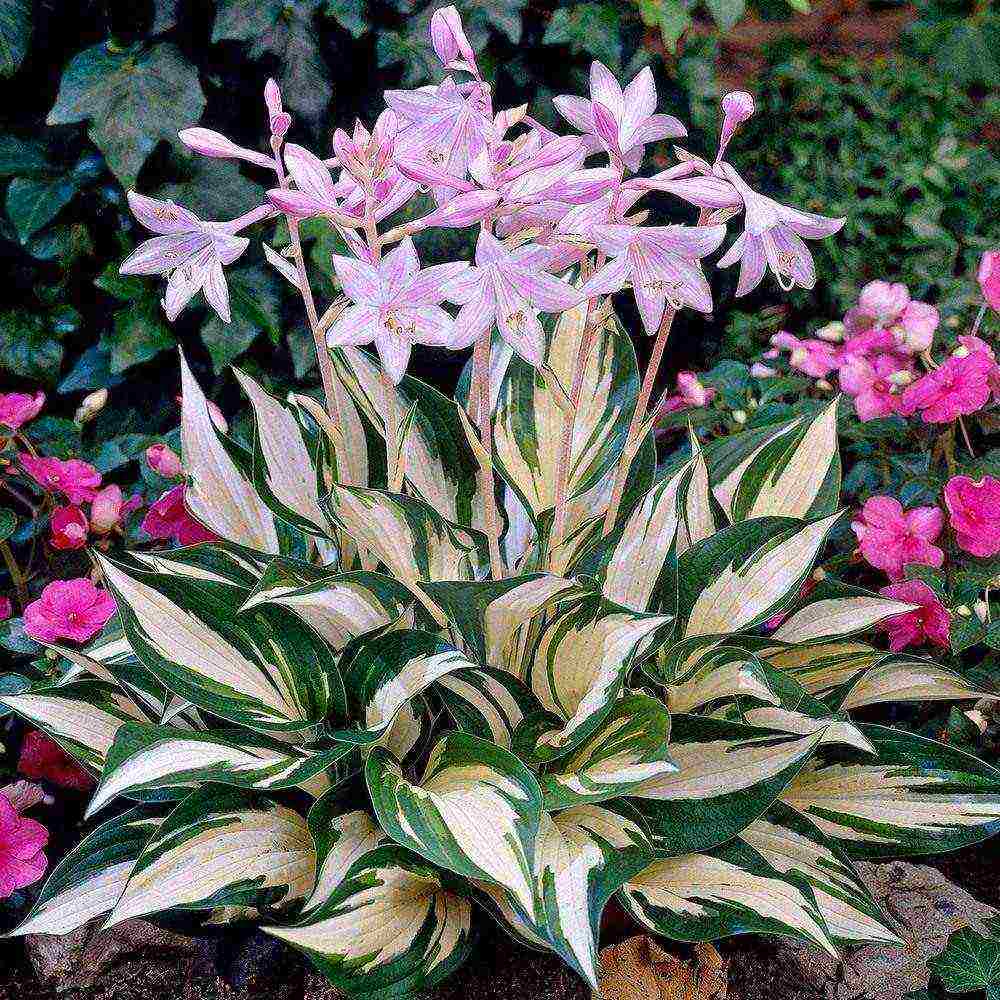
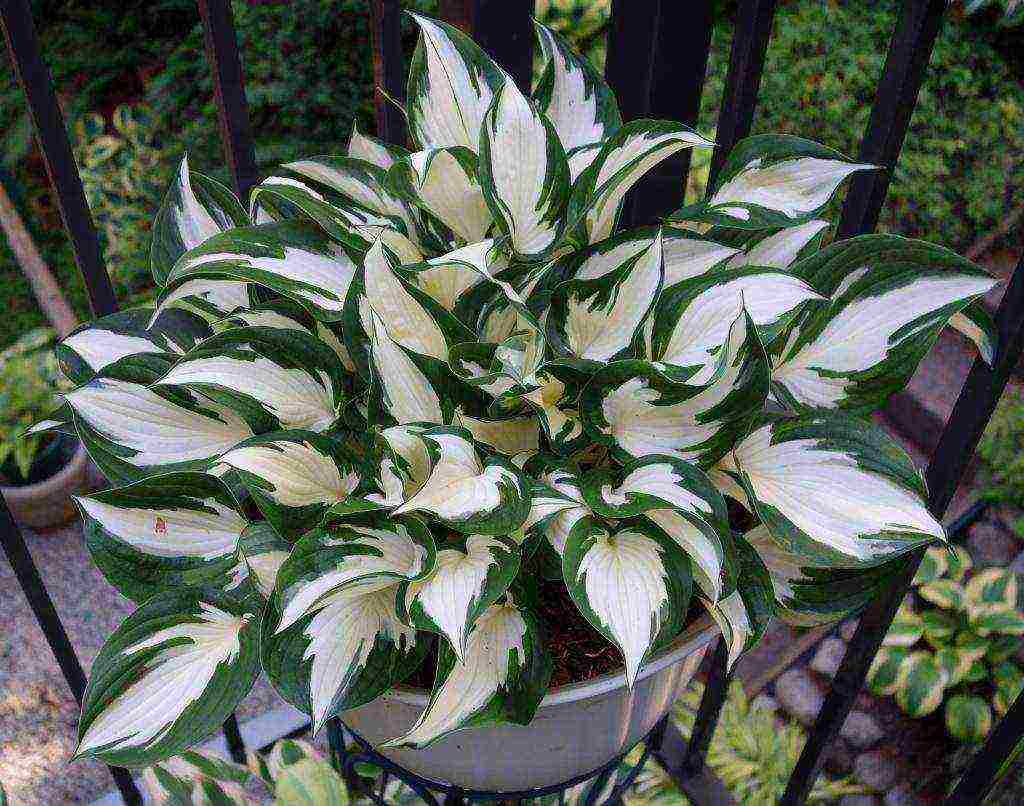
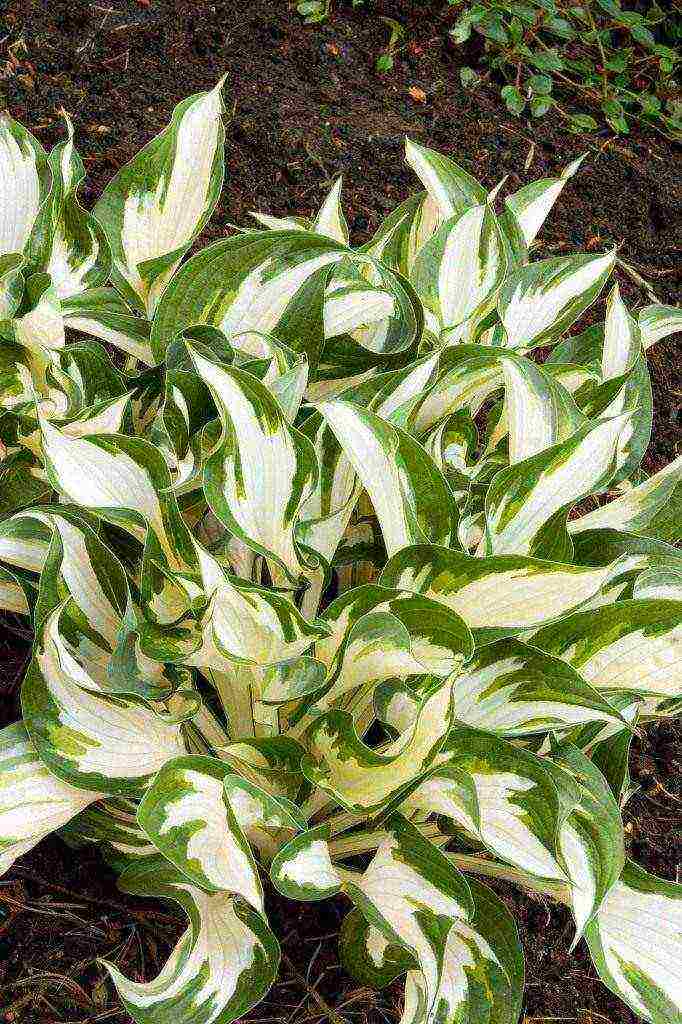
This theme was created for the publication of photos and descriptions of new, interesting or just beautiful host varieties. Place "your" varieties in the answers to this topic.
Investments:
March 10, 2016 at 15:34 # 59225 July 12, 2016 at 14:48 # 65523 August 11, 2016 at 15:32 # 66956 August 26, 2016 at 15:44 # 67775 September 7, 2016 at 15:34 # 68376 October 23, 2016 at 12 : 23 # 70443 11 January 2017 at 15:36 # 74350 13 February 2017 at 18:03 # 76062 24 February 2017 at 11:51 # 76452
Viewing 10 posts - 1 through 10 (of 31 total)
1 2 … 4 →
You must be logged in to reply to this topic.
Maxi hosts are versatile plants. They can be planted by a pond, porch, around trees, along paths, and even in a flower garden to create a backdrop. If you also want to have a giant hosta, check out the varieties.
Unlike miniature hosts, giant specimens amaze not only with the varied color and texture of the foliage, but also with their incredible size. In height, such hosts can reach 150 cm.If such a hosta grows, it alone can occupy an area 2 m wide.Therefore, when purchasing one of the varieties listed below, you must understand what will eventually grow from a seedling. Such hosts will require a lot of space.
Icy Halo
Host and Icy Halo variety will not leave indifferent fans. First of all, the plant attracts attention with its colors: huge gray-green leaves of a rounded shape are bordered by a thin white "thread". The second "trump card" of the hosts is its size. The average height of the bush is 90 cm, and its diameter is about 190 cm. It is not surprising that the plant has gained popularity among owners of large gardens. And this hosta grows well even in shaded areas.
|
Leaf color |
Flower color |
Bush height (cm) |
Bush width (cm) |
|
Gray-green with white border |
Lavender |
||
Blue Mammoth
Hosta with large bluish-blue corrugated leaves of a wide oval shape, which reaches a height of 90 cm. The plant loves partial shade and moist soil, grows quickly and is practically not susceptible to slug attack.
If flowering is not such a significant event for ordinary hosts, then the Blue Mammoth host is very good during this period. She throws out long, large peduncles on which white bell-shaped inflorescences bloom.
|
Leaf color |
Flower color |
Bush height (cm) |
Bush width (cm) |
|
Gray-blue |
White |
||
Jade Cascade
Talking about maxi-hosts, one cannot but mention this variety. The host Jade Cascade differs from the rest of the giant's in its unusual shape: it is not just a spreading bush, but a real "fountain" of leaves cascading down.
The leaves of this hosta are very large, elongated, narrowed to the tips, characterized by deep venation and wavy edges. The plant itself can reach 110 cm in height and 150 cm in width. Jade Cascade can be planted both in a sunny flowerbed and in partial shade.
|
Leaf color |
Flower color |
Bush height (cm) |
Bush width (cm) |
|
Olive |
Light lavender, almost white |
||
Dino
It is truly a giant plant, capable of growing up to 120 cm in height and 180 cm in length. Hosta can grow not only in partial shade, but also in the shade, and at the same time it does not lose its decorative effect. The leaves of the plant are rounded, rich green in color, veins and a light border are clearly expressed on it.
|
Leaf color |
Flower color |
Bush height (cm) |
Bush width (cm) |
|
Deep green |
Pale lavender |
||
Empress Wu
The largest of all the giant hosts is the Empress Wu plant. It can be up to 1.5 m high and 2.5 m wide. This hosta has huge elongated leaves collected in a vase-like bush. In spring, the foliage is covered with a waxy bloom, which gives it a matte finish, and by summer it turns dark green. The plant takes root both in the sun and in partial shade.
|
Leaf color |
Flower color |
Bush height (cm) |
Bush width (cm) |
|
Changes during the season from light green with a blue tint to dark green |
Lavender |
||
Coast to coast
The plant has earned its popularity due to the large corrugated heart-shaped leaves, along the edges of which small "waves" pass. The host itself is not too large when compared with other "giants" - it grows up to 80 cm in height and 90 cm in width.
Hosta Coast to coast feels good in sunny areas or in partial shade. With age, it turns into a sprawling bush with wavy leaves along the edge. During flowering, the culture is especially good: it is adorned with delightful lavender inflorescences.
|
Leaf color |
Flower color |
Bush height (cm) |
Bush width (cm) |
|
Changes during the season from dark to light golden |
Lavender |
||
Lush green host bushes with large leaves look great in both group and single plantings. The main thing is that you have enough space on the site to grow these huge plants.
Nature gave us more than 40 types of host... On their basis, breeders have bred many varieties that adorn gardens in many countries, although the host country is the Far East, China, and Japan.
Gardeners became interested in the beautiful-leaved Far East in the 18th century, when the Austrian N. Khost told the world about him, and a little later the German G. Funke. This is why this plant is sometimes called funkia.
In one place, hosts can grow up to 20 years, becoming more and more beautiful every year. A bush of large, juicy, with a contrasting edging of leaves makes an indelible impression. He is able to add sophistication to even the most unpretentious flower garden.
Scientists have attributed the hosta to the Liliaceae flower family. This perennial plant has a bush with a height of 15 to 120 cm, a compact rhizome and shortened stems, from which petiolate leaves extend. Their shape can be from narrow lanceolate to broadly ovate.
Leaves - the main decoration of this shade-tolerant plant. The color of the leaves is varied: dark green, bluish-gray, yellow-golden or variegated with a white pattern, with a contrasting border.
There are hosta varieties with both large and very small leaves, the size of which is slightly more than a 50-kopeck coin. In shape, they can be round, oval, heart-shaped and even with a wavy edge. Their color also pleases - green, blue, yellowish-green, as well as with variegated strokes or a white, yellowish border.
In some hosta varieties, leaf stalks look very impressive. So, the variety Red Oktober (Red October, Red October) they are reddish.
There are varieties that change the color of the leaves during the summer. Most often, this is the "sin" of varieties with a golden color, which by autumn becomes less bright. And it happens the other way around, for example, in the August Moon variety (photo in the article below, in the descriptions of the varieties), only by August does the golden color of the leaves appear.
The varieties with blue and green leaves are more stable. Hosts with wrinkled (waffle) leaves look very unusual.
Although the hostu is considered an ornamental deciduous plant, it has very graceful and bell flowers... Lilac, pink, lilac, white or lavender flowers are collected in a graceful cluster, crowning flower stalks that proudly rise above the luscious foliage.
The flowering time varies greatly depending on the variety. The early varieties bloom in July, while the later ones can delight until October. In some hosta varieties (for example, Aphrodite Aphrodite) flowers have a pleasant aroma. True, in the middle lane this variety does not bloom every year.
Let's introduce you with the most decorative types of hosts, and then a description of some of the most curious varieties will follow.
Host types
| White-bordered (Hosta albo-marginata) Hosts of this species are medium-sized, with large green leaves (length 14 cm, width up to 10 cm), decorated with a narrow white border. On peduncles 30 cm high, lilac or white flowers are formed (depending on the variety). |
| Bloated (Hosta ventricosa) A large plant with heart-shaped leaves (up to 25 cm long, 20 cm wide) with a pointed tip. Peduncles up to 1 meter high are crowned with purple flowers. |
| Wavy (Hosta undulata) Leaves are oblong (length 20 cm, width 13 cm), wavy along the edge. There are forms with a green color, with a white border, white with a green border. Peduncles up to 80 cm high are crowned with purple flowers. |
| Decorative (Hosta decorata) Bush up to 45 cm high, up to 55 cm in diameter. Leaves (length up to 15 cm, width up to 8 cm) with a sharp tip, dark green with a white border. Peduncles about half a meter high with lavender flowers. |
| Siebold (Hosta sieboldiana) The leaves are large (up to 36 cm long, 25 cm wide) with a heart-shaped base, wrinkled, dense, gray in color. Peduncles up to 40 cm high are decorated with lavender flowers. Many varieties with blue leaf color have been created with the participation of this hosta species. |
| Curly (Hosta crispula) It grows slowly, but over time forms a powerful bush. Leaves with a heart-shaped base, oblong (length up to 16 cm, width up to 10 cm), green with a narrow white border. Peduncles up to 80 cm high are decorated with lavender flowers. |
| Lanceolate (Hosta lancifolia) The plant is compact, bush up to 40 cm high and up to 50 cm in diameter. The leaves are narrow, up to 17 cm long. Peduncles up to 50 cm high are decorated with purple flowers. |
| Plantain (Hosta plantaginea) Large leaves (length 30 cm, width up to 15 cm) resemble the well-known plantain in shape. They are bright green, shiny. Peduncles up to 60 cm high are crowned with white, very fragrant flowers. On the basis of this species, garden forms with double fragrant flowers have been created. |
| Straight-leaved (Hosta rectifolia) A large plant, oblong dark green leaves (length up to 20 cm, width up to 10 cm) directed upwards. Peduncles up to 80 cm high are decorated with purple flowers. |
Description of the best hosta varieties
Hosta has long been considered a garden favorite, so all hosta varieties simply cannot be listed (there are several thousand of them), and new ones appear every year.Unfortunately, many varieties are very difficult to distinguish from each other, although there are some real highlights.
The choice of a variety directly depends on your taste. The most resistant and durable varieties are tall and medium-sized. Dwarf forms are much more capricious, they need more careful care.
Among the blue host high grades are very effective. You can choose a variety with wrinkled leaves - Big Daddy (Big Daddy) and with a smooth leaf surface - Elegans (Elegans).
Among the medium-sized varieties without competition, Halcyon, Blue Boy, Love Pat, pictured at the very beginning of the article, this hosta can grow under the bright sun.
Of the more compact ones, be sure to plant Blue Moon and Blue Cadet.
Hosts with green leaves should also grow in your garden, because it is they who help to make the transition between brightly colored varieties smoother. Hosta plantain (with pale green leaves and white fragrant flowers) and lanceolate are very popular.
An interesting miniature variety Teaspoon (Teaspoon), which, unlike most dwarfs, is very stable.
Yellow-leaved host August Moon stands out - a large plant that changes the color of the leaves from yellowish-greenish to almost lemon by the end of summer. Lemon Lime has lemon-colored leaves.
Always look spectacular varieties with a border on the leaves... Alex Summers has a creamy white border, Antioch has a yellowish border at first and then turns white.
Against a dark green background, the Patriot variety has a particularly contrasting white border. The medium-sized variety Frances Williams is distinguished by a rather wide, but blurred yellowish border against the background of bluish-green wrinkled leaves.
Golden Tiara is a miniature plant with a clear golden border around the edge of the leaf.
Hosts with a contrasting middle of the leaf attract special attention. Most often these are varieties with a white or golden center and a green edge. A great example is Inniswood (photo above) with a narrow green border and a bright yellow center.


